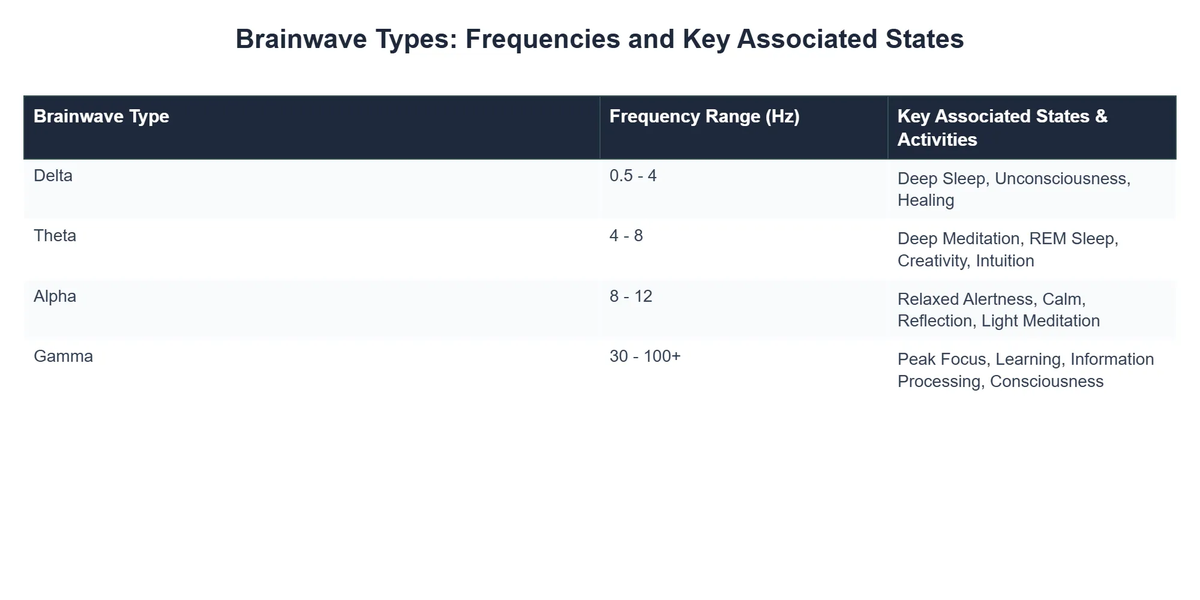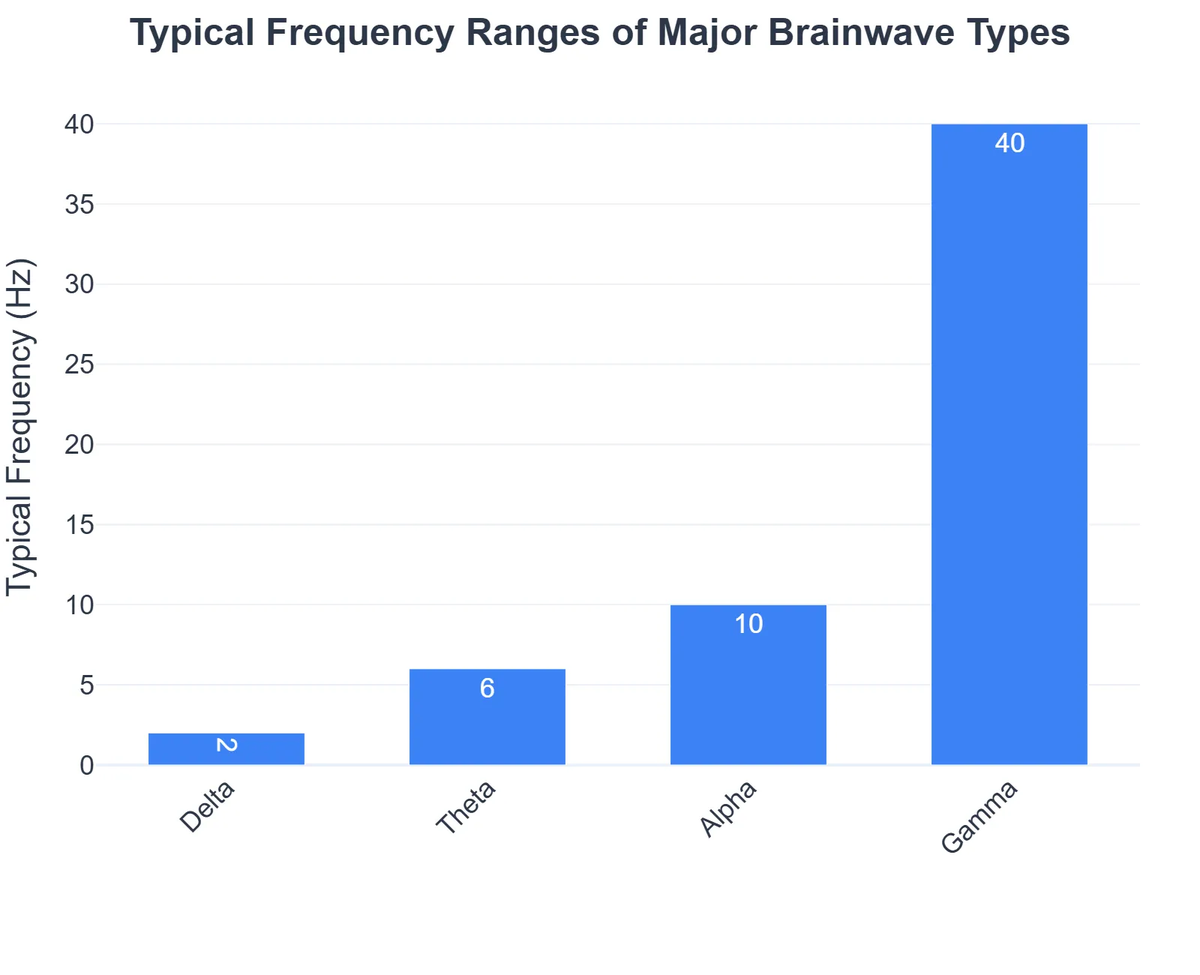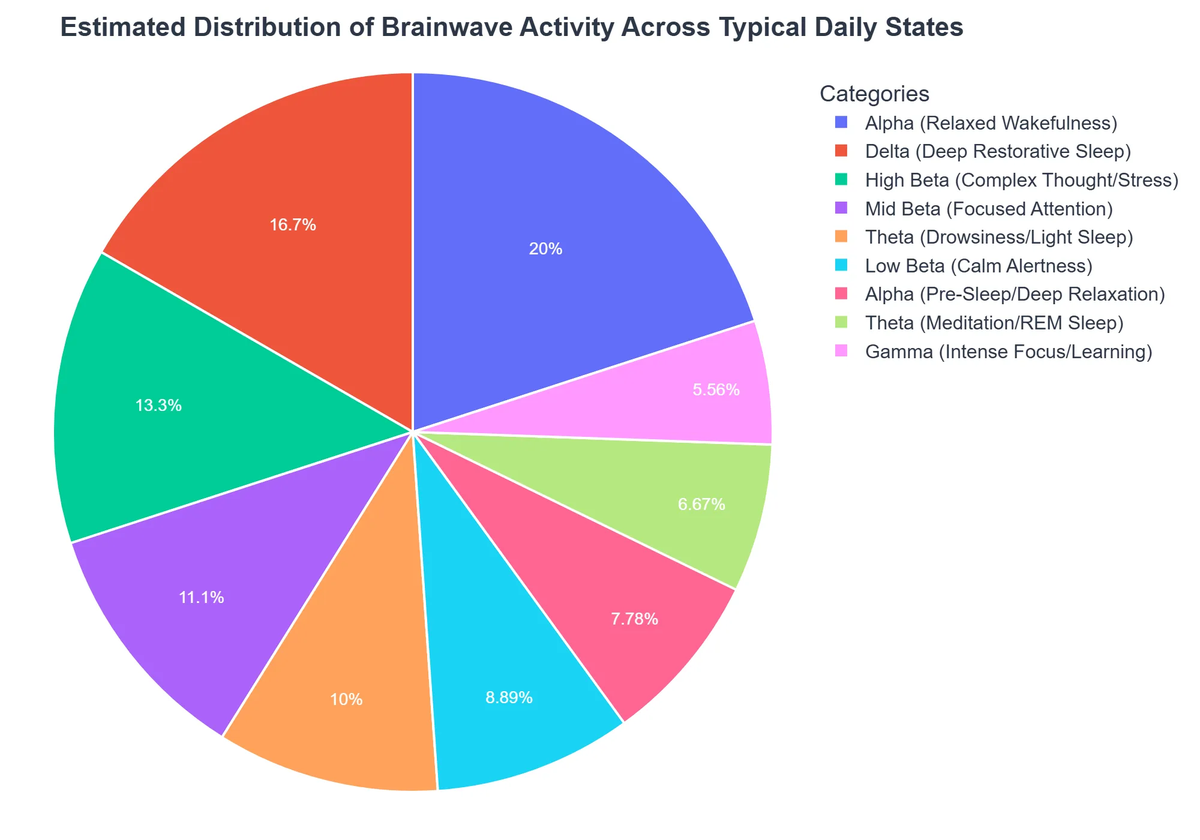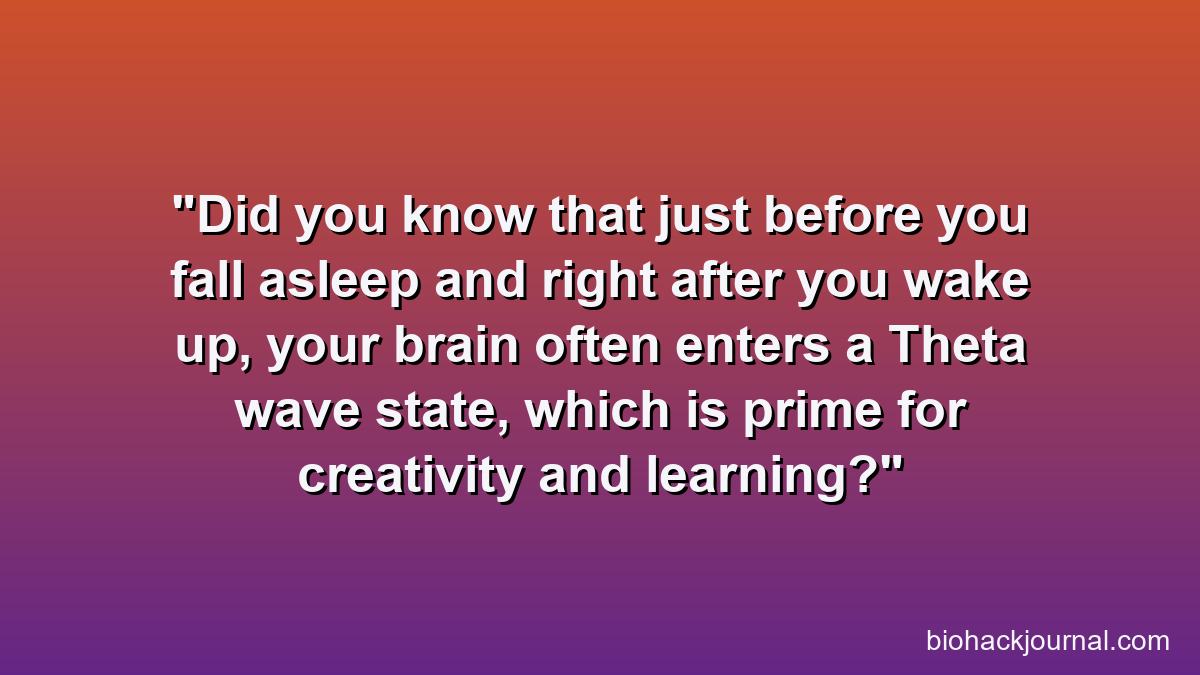Welcome to the intricate world beneath your skull, where billions of neurons hum with electrical activity, giving rise to every thought, feeling, and action you experience. This electrical symphony manifests as brainwaves – rhythmic patterns of neural oscillations that can tell us a tremendous amount about our current mental and emotional state.
💡 Key Takeaways
- Brainwaves are electrical activity in the brain, measured in Hertz, reflecting different states of consciousness.
- Alpha, Theta, Delta, and Gamma waves each correspond to distinct mental states, from deep sleep to high-level processing.
- Understanding your dominant brainwave states can help optimize focus, relaxation, and cognitive performance.
- Techniques like meditation or mindfulness can influence brainwave patterns, enhancing well-being.
“Our brainwaves are not static; they are dynamic indicators of our inner world, constantly shifting to navigate reality. Learning to attune to them offers profound insights into our mental and emotional states.”
— Dr. Evelyn Reed, Neuroscientist & Author of ‘The Rhythmic Mind’
For anyone interested in peak performance, enhanced creativity, or simply a deeper understanding of their own consciousness, grasping the different brainwave types is fundamental. From the deep repose of delta to the focused intensity of gamma, each frequency band plays a unique role in our cognitive landscape. This guide will demystify these fascinating neural rhythms, offering a comprehensive look at alpha, theta, delta, and gamma waves, and how you can consciously influence them.
Understanding these fundamental aspects of brain activity isn’t just for neuroscientists; it’s a vital component of biohacking your mind and mastering mental state control. Let’s dive in.
In This Article
- — 💡 Key Takeaways
- → What Are Brainwaves? The Electrical Language of Your Brain
- — 🔬 The Electroencephalogram (EEG) Explained
- → The Five Primary Brainwave Frequencies: An Overview
- → Delta Waves (0.5-4 Hz): The Deep Sleep Maestro
- — 😴 Characteristics & Associated States
- — 💡 Encouraging Delta Activity
- → Theta Waves (4-8 Hz): The Realm of Dreams & Deep Insight
- — ✨ Characteristics & Associated States
- — 🧘 Cultivating Theta States
- → Alpha Waves (8-12 Hz): The Bridge to Calm & Creativity
- — 🧠 Characteristics & Associated States
- — 🎨 Boosting Alpha Production
- → Beta Waves (12-30 Hz): The Mind in Action
- — ⚡ Characteristics & Associated States
- — ⚖️ Balancing Beta Activity
- → Gamma Waves (30-100+ Hz): The Peak Performance State
- — 🌟 Characteristics & Associated States
- — 🚀 Fostering Gamma Spikes
- → How to Influence Your Brainwaves for Optimal States
- — 🧘 Meditation & Mindfulness
- — 🎶 Sound & Brainwave Entrainment
- — ⚡ Neurofeedback & Biofeedback
- — 🥗 Lifestyle & Nutrition
- → Measuring Your Brain’s Electrical Symphony
- — 🔬 Clinical EEG: The Gold Standard
- — 🏠 Consumer EEG Devices: Accessibility for All
- → The Power of Brainwave Understanding in Biohacking & Mental State Control
- → Conclusion: Harmonizing Your Inner Symphony
What Are Brainwaves? The Electrical Language of Your Brain
At its core, your brain is an electrochemical organ. Neurons, the fundamental building blocks of the brain, communicate with each other through tiny electrical impulses. When millions of these neurons fire in synchronicity, they generate an electrical pulse strong enough to be detected by sensors placed on the scalp. These detectable electrical patterns are what we refer to as brainwaves, or neural oscillations.
Think of brainwaves like musical notes. Each note has a different frequency, and when combined, they create a complex melody. Similarly, brainwaves are measured in Hertz (Hz), representing cycles per second. Different frequencies correspond to different states of consciousness and mental activity. Your brain is constantly producing a combination of these frequencies, with one or two typically dominating depending on what you’re doing.

🔬 The Electroencephalogram (EEG) Explained
The primary tool used by neuroscientists and clinicians to measure brainwaves is the Electroencephalogram (EEG). An EEG involves placing electrodes on the scalp, which pick up the electrical signals generated by the brain. These signals are then amplified and displayed as a wave pattern, allowing researchers to observe the frequency, amplitude, and location of brainwave activity.
For a detailed look at the technology behind brainwave measurement, you can explore comprehensive guides on EEG (Electroencephalography).
The Five Primary Brainwave Frequencies: An Overview
While the brain produces a continuous spectrum of frequencies, scientists typically categorize them into five distinct bands, each associated with specific mental states and characteristics. These are Delta, Theta, Alpha, Beta, and Gamma waves. Understanding these distinct brainwave frequencies is crucial for anyone looking to optimize their cognitive performance and emotional well-being.
- ✅ Delta Waves (0.5 – 4 Hz): Deep, restorative sleep.
- ✅ Theta Waves (4 – 8 Hz): Deep meditation, creativity, dreams, REM sleep.
- ✅ Alpha Waves (8 – 12 Hz): Relaxed wakefulness, light meditation, calm focus.
- ✅ Beta Waves (12 – 30 Hz): Active thinking, alertness, concentration, problem-solving.
- ✅ Gamma Waves (30 – 100+ Hz): Peak concentration, insight, information processing, cognitive binding.
Delta Waves (0.5-4 Hz): The Deep Sleep Maestro
Delta waves are the slowest and highest amplitude brainwaves, predominantly associated with deep, dreamless sleep. They are crucial for physical regeneration, hormonal balance, and overall well-being. When your brain is generating significant delta activity, it indicates a state of profound rest and healing.
😴 Characteristics & Associated States
- ✅ Frequency Range: 0.5 to 4 Hz.
- ✅ Dominant State: Deep sleep (NREM Stage 3 & 4), also present in very deep meditative states.
- ✅ Key Benefits: Physical restoration, growth hormone release, immune system boosting, deep relaxation, unconscious processing.
- ✅ Lack of Delta: Can lead to fatigue, poor physical health, and difficulty feeling rested.
💡 Encouraging Delta Activity
Cultivating healthy delta wave activity is essential for restorative sleep. Strategies include:

- 🛌 Prioritizing Sleep: Aim for 7-9 hours of quality sleep per night.
- 🧘 Deep Relaxation Techniques: Practices like Yoga Nidra or body scan meditations can help induce delta-like states.
- 🔇 Creating a Sleep-Friendly Environment: Dark, quiet, and cool bedrooms promote deeper sleep.
- 🍽️ Mindful Eating: Avoiding heavy meals and stimulants like caffeine or alcohol before bed.
Theta Waves (4-8 Hz): The Realm of Dreams & Deep Insight
Theta waves are often described as the “subconscious gateway.” They emerge during states of deep relaxation, meditation, and REM sleep, where dreaming occurs. This is the realm of creativity, intuition, and memory consolidation. When you’re in a theta state, your mind is open to learning, insights, and personal growth.
✨ Characteristics & Associated States
- ✅ Frequency Range: 4 to 8 Hz.
- ✅ Dominant State: Deep meditation, REM sleep, hypnosis, moments of sudden insight (the “aha!” moment), daydreaming.
- ✅ Key Benefits: Enhanced creativity, intuitive insights, emotional healing, memory consolidation, reduced anxiety.
- ✅ Excess Theta: Can lead to spaciness, difficulty concentrating, or feeling “foggy.”
🧘 Cultivating Theta States
Accessing theta states can unlock significant cognitive and emotional benefits:
- 🌿 Guided Meditation: Meditations specifically designed for deep relaxation or inner journeying.
- 🎨 Creative Flow: Engaging in activities that put you in a flow state, like painting, writing, or playing music.
- 😴 Hypnosis: A therapeutic technique that guides you into a highly suggestible, relaxed theta state.
- 🎶 Binaural Beats: Listening to audio frequencies engineered to encourage theta wave production.
Alpha Waves (8-12 Hz): The Bridge to Calm & Creativity
Alpha waves are the bridge between your conscious and subconscious mind. They are prominent during relaxed wakefulness, when you’re calm, reflective, and not actively processing a lot of information. This state is ideal for light meditation, brainstorming, and accessing a state of effortless flow.
🧠 Characteristics & Associated States
- ✅ Frequency Range: 8 to 12 Hz.
- ✅ Dominant State: Relaxed, reflective wakefulness; light meditation; creative visualization; pre-sleep and post-sleep states.
- ✅ Key Benefits: Stress reduction, enhanced creativity, improved learning ability, increased intuition, a sense of calm and well-being.
- ✅ Lack of Alpha: Can lead to anxiety, stress, or difficulty relaxing.
🎨 Boosting Alpha Production
Increasing your alpha wave activity can lead to a more relaxed and creative mind:
- 🧘 Mindfulness Meditation: Focusing on your breath or body sensations without judgment.
- 🌳 Spending Time in Nature: The calming effect of natural environments often induces alpha waves.
- 🎶 Listening to Calming Music: Classical, ambient, or nature sounds can help.
- 🌬️ Deep Breathing Exercises: Slow, diaphragmatic breathing activates the parasympathetic nervous system, promoting alpha.
Beta Waves (12-30 Hz): The Mind in Action
Beta waves are your “waking consciousness” waves. They are dominant when you are alert, focused, and actively engaged in cognitive tasks including problem-solving, decision-making, or intense concentration. While essential for daily functioning, excessive beta activity can lead to stress and anxiety.

⚡ Characteristics & Associated States
- ✅ Frequency Range: 12 to 30 Hz.
- ✅ Dominant State: Active thinking, problem-solving, concentration, alertness, anxiety, stress.
- ✅ Key Benefits: Enhanced focus, sharp cognition, quick decision-making, effective task performance.
- ✅ Excess Beta: Can manifest as anxiety, restlessness, insomnia, or overthinking.
- ✅ Low Beta: May result in brain fog, difficulty concentrating, or depression.
⚖️ Balancing Beta Activity
Optimizing beta waves means having enough for focus without succumbing to excessive stress:
- 🗓️ Time Management: Structure your day to avoid overwhelming your cognitive load.
- ⏸️ Regular Breaks: Step away from demanding tasks to allow your mind to decompress.
- 🧘 Mind-Body Practices: Techniques like meditation (to transition to alpha/theta) or yoga can help regulate overall brain activity.
- ☕ Caffeine Awareness: While stimulants boost beta, overconsumption can lead to anxiety and burnout.
Gamma Waves (30-100+ Hz): The Peak Performance State
Gamma waves are the fastest brainwaves and are associated with peak performance, high-level information processing, and states of heightened awareness and consciousness. They are thought to play a role in “cognitive binding,” linking information from various parts of the brain to form coherent perceptions and insights.
🌟 Characteristics & Associated States
- ✅ Frequency Range: 30 to 100+ Hz (some research extends to 200 Hz).
- ✅ Dominant State: Peak concentration, intense focus, problem-solving, moments of universal insight, empathy, heightened perception, mystical experiences.
- ✅ Key Benefits: Enhanced memory recall, increased processing speed, heightened sensory perception, superior cognitive function, and emotional intelligence.
- ✅ Imbalances: Lower gamma activity has been linked to certain cognitive impairments, while excessively high, sustained gamma may be associated with anxiety in some contexts.
🚀 Fostering Gamma Spikes
While often elusive, some practices can encourage gamma activity:
- 🧠 Advanced Meditation Practices: Long-term meditators, particularly those practicing compassion or ‘loving-kindness’ meditation, often exhibit strong gamma synchrony.
- 💪 Intense Focus Tasks: Engaging in complex problem-solving or deep learning that requires high cognitive integration.
- 🎶 Music with Specific Rhythms: Some studies suggest certain musical patterns can influence gamma activity.
- 🧩 Novelty & Learning: Consistently challenging your brain with new information and experiences.
How to Influence Your Brainwaves for Optimal States
The exciting news is that you’re not merely a passive recipient of your brainwave patterns. Through various practices and tools, you can actively train your brain to shift into desired frequency states, optimizing your mind for specific tasks or experiences. This is where the power of brainwave understanding truly comes into its own as a biohacking tool.
🧘 Meditation & Mindfulness
Meditation is one of the most powerful and well-researched methods for influencing brainwave patterns. Different meditation styles can emphasize different brainwave states:
- ✅ Calm-Abiding (Shamatha) Meditation: Often increases alpha waves for relaxation and can lead to theta for deeper insights.
- ✅ Transcendental Meditation (TM): Known for increasing alpha and theta activity, promoting deep rest and inner peace.
- ✅ Compassion/Loving-Kindness Meditation: Can significantly boost gamma wave activity, leading to heightened empathy and interconnectedness.
- ✅ Focused Attention Meditation: May temporarily increase beta or even gamma for sharp focus.
🎶 Sound & Brainwave Entrainment
Brainwave entrainment is a technique that uses rhythmic stimuli (such as sound or light) to alter brainwave frequencies. The brain has a tendency to synchronize its electrical activity with external rhythms. This is often achieved through:
- 🎧 Binaural Beats: Different frequencies are played into each ear, and the brain perceives a third, “beat” frequency, which it then tries to match. For example, 400 Hz in one ear and 410 Hz in the other creates a 10 Hz beat, aiming for alpha waves.
- 🔊 Isochronic Tones: Single tones that rapidly turn on and off, creating a pulsating rhythm. These are often considered more effective as the brain doesn’t need to ‘calculate’ a difference.
- 💡 Monaural Beats: Two tones mixed outside the brain that create a single perceived beat.
To explore how these technologies can assist in achieving meditative states, check out our guide on Top Brainwave Entrainment Devices for Meditative States: A Buyer’s Guide.
⚡ Neurofeedback & Biofeedback
Neurofeedback is a form of biofeedback that allows individuals to train their brainwaves directly. Sensors are placed on the scalp to monitor brain activity, which is then displayed to the individual in real-time (e.g., as a game or a visual display). When the brain produces the desired brainwave pattern, the individual receives positive feedback (e.g., the game progresses or a sound plays). This allows the brain to learn to self-regulate its activity. You can learn more about this fascinating field through resources on Neurofeedback: A Comprehensive Review.
🥗 Lifestyle & Nutrition
While not as direct as meditation or entrainment, lifestyle factors significantly impact overall brain health and, consequently, brainwave patterns:
- ✅ Balanced Diet: Nutrient-rich foods support neurotransmitter production and neuronal health.
- ✅ Regular Exercise: Improves blood flow to the brain, reduces stress, and can enhance cognitive function.
- ✅ Adequate Sleep: Crucial for delta and theta wave production, supporting restoration and memory.
- ✅ Stress Management: Chronic stress can lead to excessive beta activity; managing it helps balance brainwave states.
Measuring Your Brain’s Electrical Symphony
While you can’t see your brainwaves, various technologies allow us to measure and even visualize their activity. This measurement is key to understanding and, ultimately, influencing your mental states.
🔬 Clinical EEG: The Gold Standard
As mentioned, the Electroencephalogram (EEG) is the clinical gold standard for measuring brain electrical activity. It’s used in hospitals and research settings to diagnose neurological conditions like epilepsy, sleep disorders, and even monitor brain function during surgery.
🏠 Consumer EEG Devices: Accessibility for All
In recent years, advancements in technology have made EEG devices accessible to the public. These consumer-grade devices, often in the form of headbands or portable sensors, can track and provide feedback on your brainwave activity during meditation, sleep, or daily tasks. While not as precise as clinical EEGs, they offer a valuable tool for personal brainwave training and self-discovery.
The Power of Brainwave Understanding in Biohacking & Mental State Control
Understanding your brainwave patterns empowers you to take a more active role in managing your mental and emotional states. Whether you aim to enhance focus for work (beta/gamma), foster creativity (theta), achieve deep relaxation (alpha), or promote restorative sleep (delta), knowledge of brainwaves provides a roadmap.
This insight is a cornerstone of The Neuroscience of Meditation: Understanding Brainwaves and Neuroplasticity. By learning to consciously shift your brainwave patterns, you engage in a powerful form of self-regulation, unlocking potential for improved well-being, cognitive performance, and a deeper connection to your inner world. This ability to influence brain states also ties directly into the concept of Rewiring Your Brain: The Profound Impact of Meditation on Neuroplasticity, where consistent practice can lead to lasting changes in brain structure and function.
Recommended Video
Conclusion: Harmonizing Your Inner Symphony
Your brain is a dynamic orchestra, constantly playing a symphony of electrical rhythms. By understanding the roles of delta, theta, alpha, beta, and gamma waves, you gain invaluable insight into your own consciousness and how to navigate its various states. From the depths of restorative sleep to the heights of peak performance, each brainwave frequency offers unique benefits and opportunities for growth.
Embracing practices like meditation, sound entrainment, and lifestyle adjustments allows you to consciously influence these internal rhythms, transforming yourself from a passive listener to the conductor of your own brain’s symphony. Begin your journey today and unlock the profound potential of your mind.
Frequently Asked Questions
What are brainwaves?
Brainwaves are rhythmic electrical impulses produced by the brain, measured in Hertz (Hz), that indicate different states of consciousness and mental activity.
How do different brainwave types relate to mental states?
Delta waves are associated with deep sleep, Theta with meditation/light sleep, Alpha with relaxed alertness, and Gamma with peak concentration and cognitive processing.
Can I influence my own brainwaves?
Yes, practices like meditation, mindfulness, biofeedback, and even specific sounds (binaural beats) can help guide your brain into desired brainwave states.
Why is understanding brainwaves important?
Understanding brainwaves can help optimize cognitive function, improve sleep, manage stress, enhance focus, and gain deeper insights into your own consciousness.

